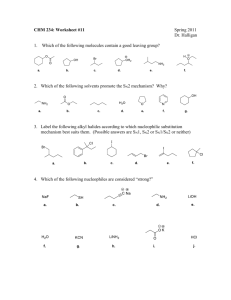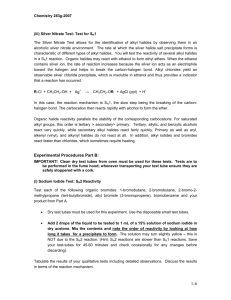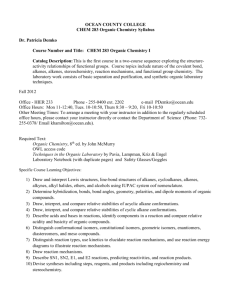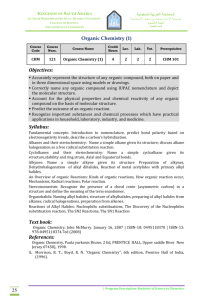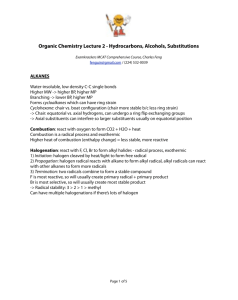ch07 Worksheet Part 2-Elimination reactions Answer Key
advertisement
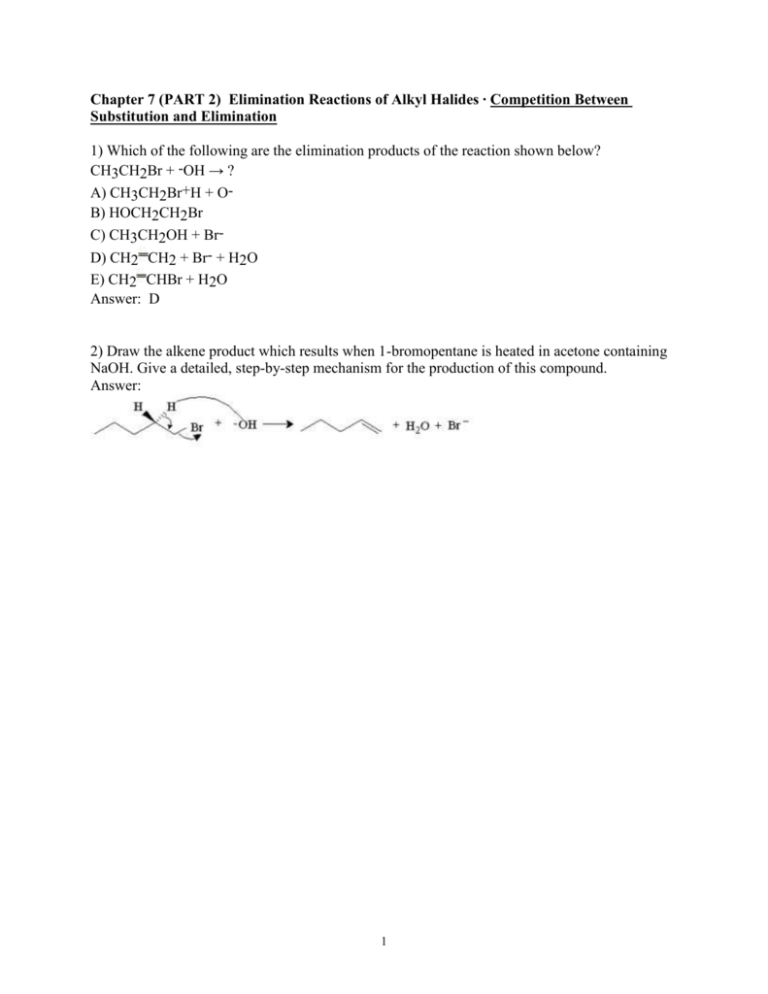
Chapter 7 (PART 2) Elimination Reactions of Alkyl Halides ∙ Competition Between Substitution and Elimination 1) Which of the following are the elimination products of the reaction shown below? CH3CH2Br + -OH → ? A) CH3CH2Br+H + OB) HOCH2CH2Br C) CH3CH2OH + BrD) CH2 CH2 + Br- + H2O E) CH2 CHBr + H2O Answer: D 2) Draw the alkene product which results when 1-bromopentane is heated in acetone containing NaOH. Give a detailed, step-by-step mechanism for the production of this compound. Answer: 1 3) Give the mechanism of the reaction shown below. Answer: 2 4) Give the mechanism of the reaction shown below. Answer: 5) What is the most reactive alkyl halide for elimination reactions? A) 1-chlorobutane B) 1-fluorobutane C) 1-iodobutane D) 1-bromobutane Answer: C 6) Which alkyl halide reacts the fastest in an E2 reaction? A) 2-chloro-2-methylbutane B) 1-chlorobutane C) 1-chloro-2-methylbutane D) 2-chlorobutane E) chloromethane Answer: A 3 7) Give the major product for the following E2 reaction. A) B) C) D) E) none of the above Answer: A 4 8) Give the major product for the E2 reaction. A) B) C) D) E) Answer: D 5 9) Give the major product for the following E2 reaction. A) B) C) D) E) Answer: A 6 10) Which of the following compounds undergoes E2 reactions with the fastest rate? A) B) CH3CH2CH2Cl C) CH3CH2CH2I D) E) CH3CH2CH2Br Answer: D 11) Which of the following bases gives the highest anti-Zaitsev product in E2 reactions when reacted with 2-bromo-2, 3-dimethylbutane? A) B) C) D) E) Answer: E 7 12) What is the major product of the following E2 reaction? A) B) CH3CH2CH CH2 C) D) E) Answer: C 8 13) Which of the alkyl chlorides listed below undergoes dehydrohalogenation in the presence of a strong base to give 2-pentene as the only alkene product? A) 1-chloropentane B) 2-chloropentane C) 3-chloropentane D) 1-chloro-2-methylbutane E) 1-chloro-3-methylbutane Answer: C 14) What is the major organic product of the following reaction? A) 2,3-dimethyl-1-hexene B) 2,3-dimethyl-2-hexene C) 2-isopropyl-1-pentene D) (Z)-2,3-dimethyl-3-hexene E) (E)-2,3-dimethyl-3-hexene Answer: B 9 15) What is the major organic product of the following reaction? A) 2,3-dimethyl-1-hexene B) 2,3-dimethyl-2-hexene C) 2-isopropyl-1-pentene D) (Z)-2,3-dimethyl-3-hexene E) (E)-2,3-dimethyl-3-hexene Answer: C 16) When 1-iodo-1-methylcyclohexane is treated with NaOCH2CH3, the more highly substituted alkene product predominates. When KOC(CH3)3 is used instead, the less highly substituted alkene product predominates. Offer an explanation. Answer: The unhindered ethoxide produces the more stable alkene product (ie, the more highly substituted alkene possible). When the bulky t-butoxide is used, the most accessible hydrogen is removed. This results in the least highly substituted alkene possible. 17) Provide the structure of the major organic product which results when 2-bromo-2methylbutane is treated with sodium ethoxide. Answer: 18) Draw all likely alkene products in the following reaction and circle the product you expect to predominate. Answer: 10 19) Draw all likely alkene products in the following reaction and circle the product you expect to predominate. Answer: 20) Draw all likely alkene products in the following reaction and circle the product you expect to predominate. Answer: 11 21) Provide the structure of the major organic product of the following reaction. Answer: 22) Provide the structure of the major organic product of the following reaction. Answer: 23) Provide the major organic product of the following reaction. Answer: 12 24) Provide the major organic product of the following reaction. Answer: 25) Provide the major organic product of the following reaction. Answer: 26) Provide the major organic product of the following reaction. Answer: 27) Provide the major organic product of the following reaction. Answer: 13 28) Which of the following alkyl halides undergoes E1 reactions with the fastest rate? A) B) C) D) E) CH3I Answer: D 29) Which of the following alkyl halides forms the most stable carbocation when it undergoes an E1 reaction? A) I B) II C) III D) IV E) V Answer: D 14 30) Which of the following statements correctly describe(s) E1 reactions of alkyl halides (RX)? I. Rate = k[base] II. Rate = k[base][RX] III. Rate = k[RX] IV. The reactions occur in two distinct steps. V. Rearrangements are sometimes seen. A) II and IV B) III and V C) I, IV, and V D) I only E) III, IV, and V Answer: E 31) When 1-bromo-2,2-dimethylcyclopentane is heated in ethanol, one of the products which results is shown below. Provide a detailed, stepwise mechanism for the production of this compound, and give the name of the mechanism by which it is produced. Answer: 15 32) List the following compounds in order of increasing reactivity in an E1 elimination. CH3CH2CHBrCH3, CH3CH2CH2CH2Br, (CH3)3CBr Answer: CH3(CH2)3Br < CH3CH2CHBrCH3 < (CH3)3CBr 1) Give the mechanism of the reaction shown below. Answer: 16 33) Give the mechanism of the reaction shown below. Answer: 17 34) Give the major product for the following E1 reaction. A) B) C) D) E) Answer: D 35) Dehydrohalogenation of 2-bromobutane in the presence of a strong base proceeds via which of the following mechanistic pathways? A) SN1 B) SN2 C) E1 D) E2 E) none of the above Answer: D 18 36) Provide the structure of the major organic product in the following reaction. Answer: 37) Why is the E1 not a likely mechanism when 1-chloropentane is heated in ethanol? Answer: Primary halides cannot undergo E1 reactions because of the difficulty encountered in forming primary carbocations. 38) Which of the following is least likely to be found in the product mixture which results when 2-iodopentane reacts with sodium ethoxide in ethanol? A) 1-ethoxypentane B) 2-ethoxypentane C) (Z)-2-pentene D) (E)-2-pentene E) 1-pentene Answer: A 39) Why is the alkyl halide below not capable of undergoing an E2 reaction upon treatment with sodium ethoxide? A) Br- is too poor a leaving group. B) The substrate is too hindered. C) Too much angle strain would be present in the alkene product. D) Sodium ethoxide is a poor base to use in E2 reactions. E) The C-H and C-Br bonds which need to break cannot achieve an anti-periplanar orientation. Answer: E 19 40) Which of the compounds shown below is/are the product(s) of this reaction? A) I only B) II only C) I and II are of equal yield. D) I is major, II is minor. E) I is minor, II is major. Answer: A 20 41) Which of the following compounds is/are the products of the following reaction? A) I only B) II only C) I and II are of equal yield. D) I is major, II is minor. E) I is minor, II is major. Answer: E 42) Provide the structure of the major organic product which results in the following reaction. Answer: 21 43) Provide the structure of the major elimination product which results when the alkyl bromide below is heated in ethanol. Answer: 44) What is the major product of the following reaction? A) CH2 CHCH2CH3 B) CH3CH CHCH3 C) D) CH3CH2CH2CH2OCH2CH3 E) Answer: B 22 45) What is the major product of the following reaction? A) I B) II C) III D) IV E) V Answer: E 46) What is/are the product(s) of the following reaction? A) B) CH2 CH2 C) D) A and B E) A and C Answer: C 23 47) What is/are the product(s) of the following reaction? A) B) CH2 CH2 C) D) A and B E) A and C Answer: D 24 48) What mechanism predominates in the reaction below? A) SN2 B) SN1 without rearrangement C) SN1 with rearrangement D) E2 E) E1 Answer: A 49) What mechanism predominates in the reaction below? A) SN2 B) SN1 without rearrangement C) SN1 with rearrangement D) E2 E) E1 Answer: C 50) What mechanism predominates in the reaction below? A) SN2 B) SN1 without rearrangement C) SN1 with rearrangement D) E2 E) E1 Answer: D 25 51) Which of the following is least likely to be found in the product mixture which results when the alkyl iodide below is heated in water? A) I B) II C) III D) IV E) V Answer: D 52) Provide the structure of the major organic product of the following reaction. Answer: 26 53) Can primary alkyl halides react by SN2, SN1, E2, and E1 mechanisms? Are any of these mechanisms prohibited? What conditions favor a particular mechanism? Answer: Only SN2 and E2 pathways are available to primary halides. SN1 and E1 cannot occur due to the instability of primary carbocations. SN2 will typically predominate over E2 unless there is steric hindrance in the alkyl halide or nucleophile/base. 54) What reaction mechanism predominates when 1-bromo-1-propylcyclopentane is treated with sodium methoxide in methanol? Answer: E2 55) What reaction mechanism predominates when 1-bromo-1-propylcyclopentane is heated in ethanol? Answer: SN1 56) Provide the major organic product(s) in the reaction below. Answer: 27 57) Give the major product(s) for the following reaction. A) B) C) D) E) F) Answer: A, E 28 58) Provide the major organic product of the following reaction. Answer: 29 59) Provide the major organic product of the following reaction. Answer: 30
